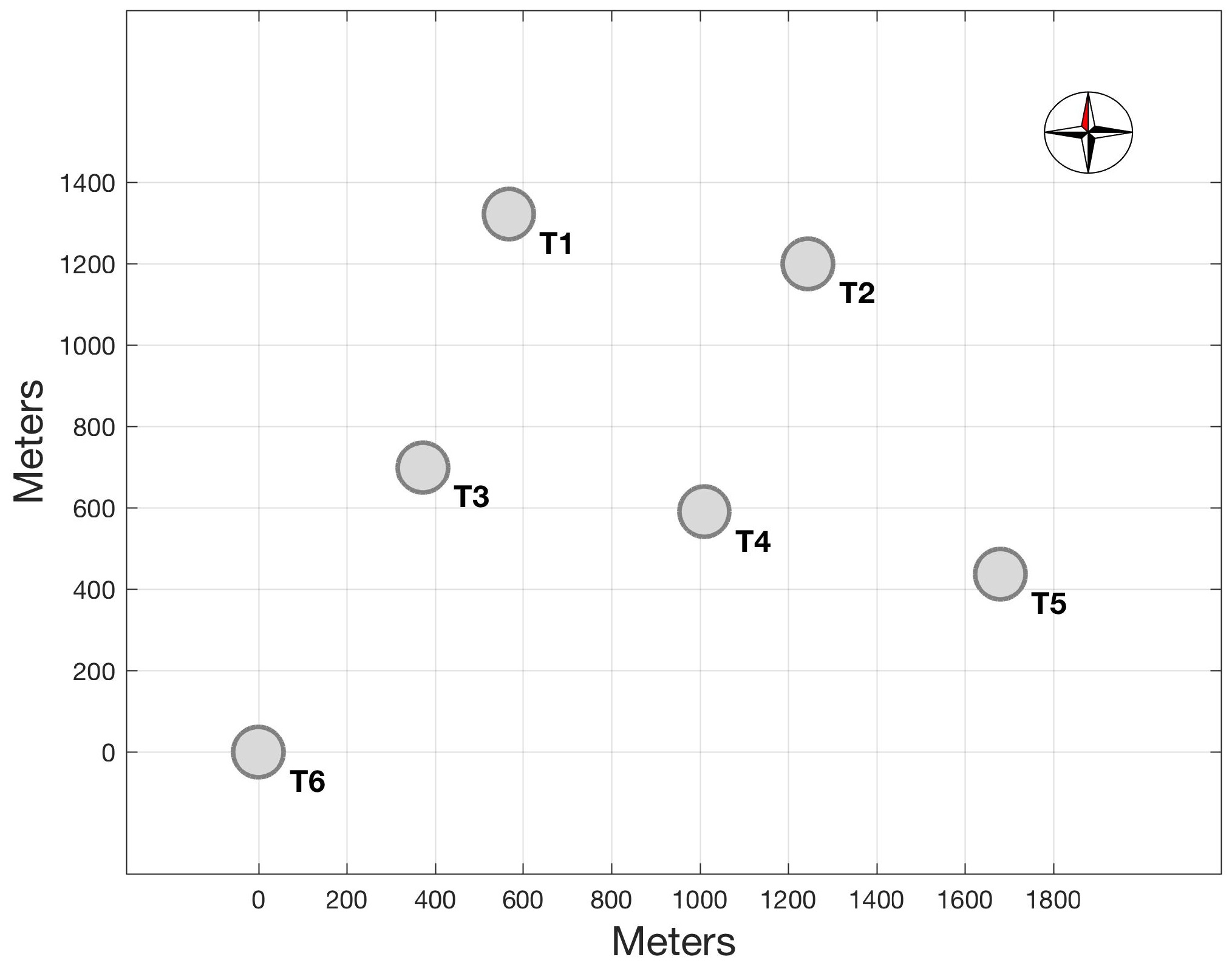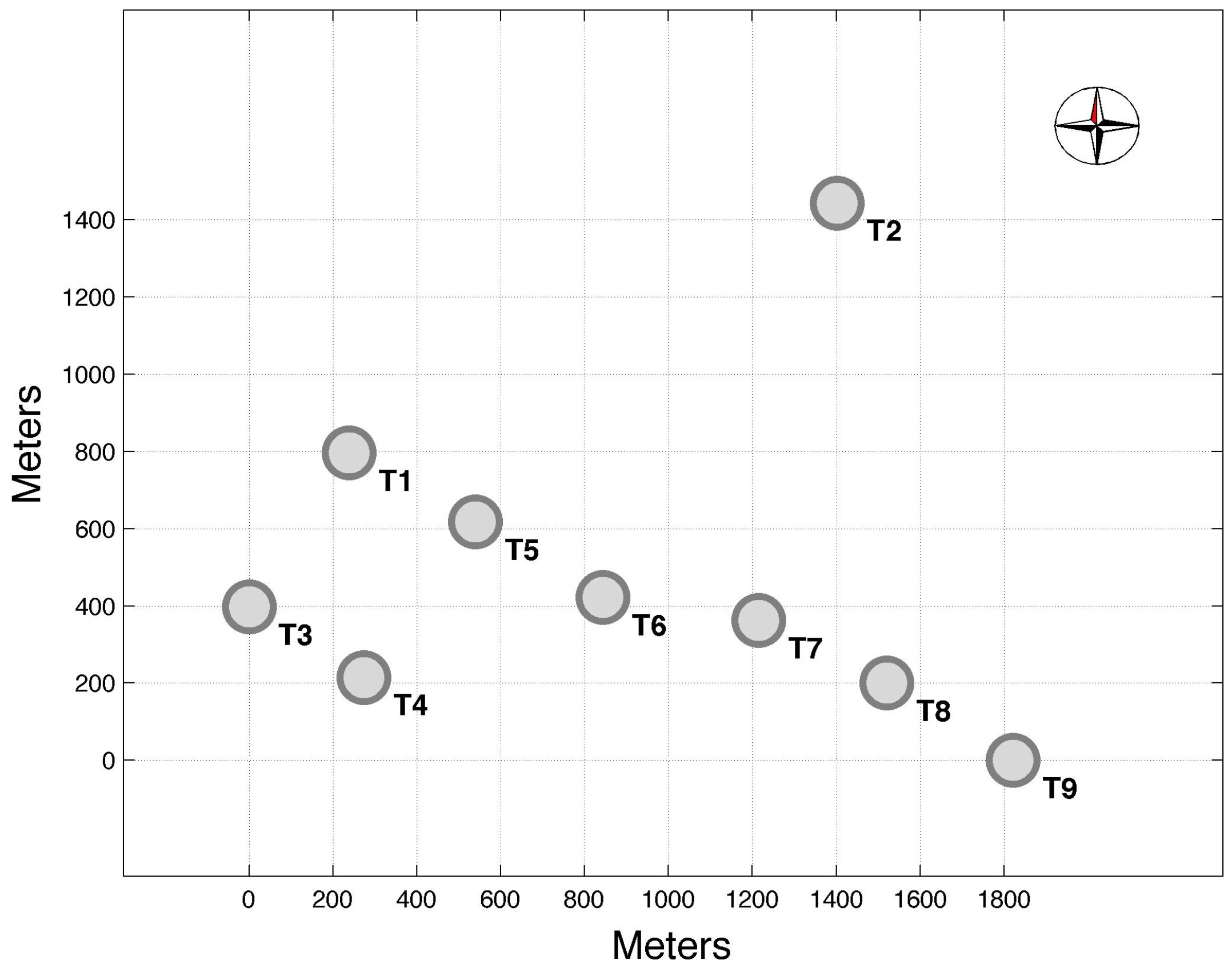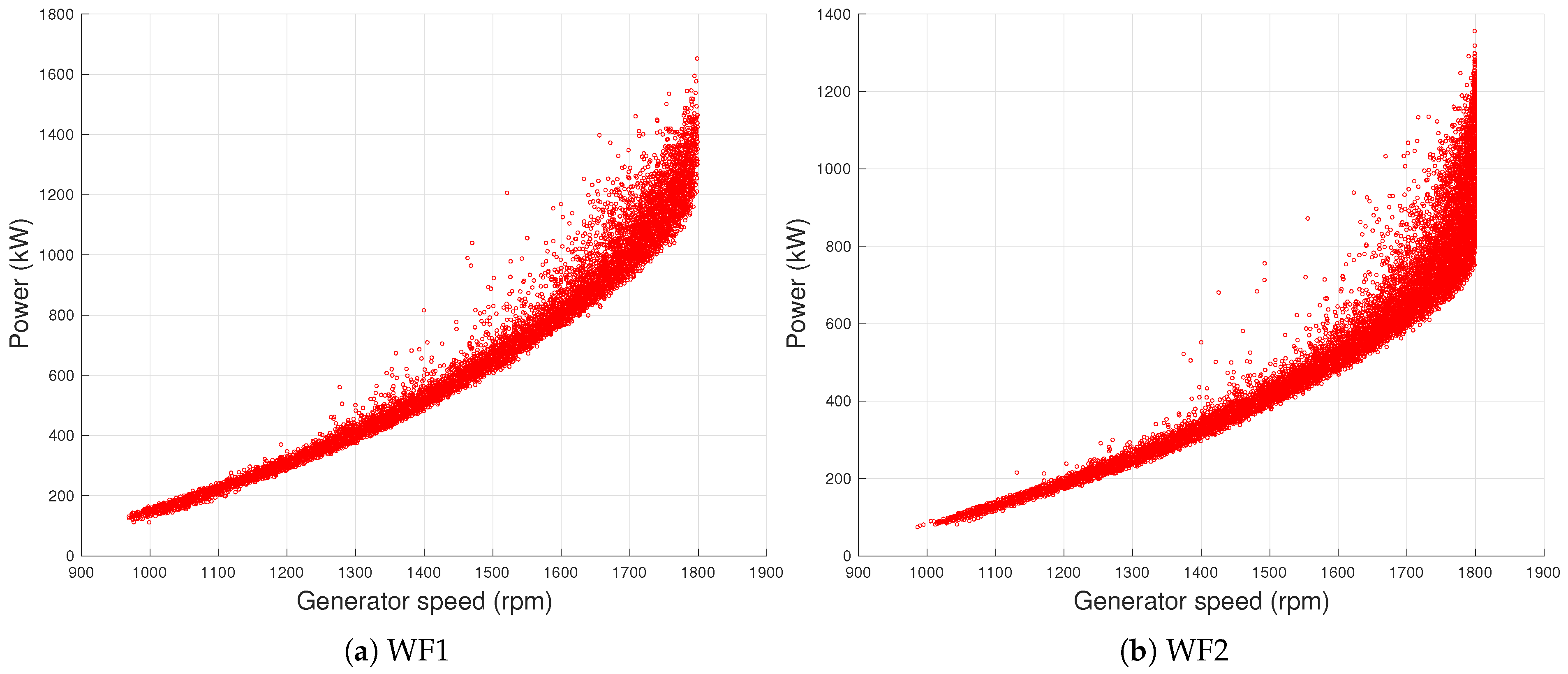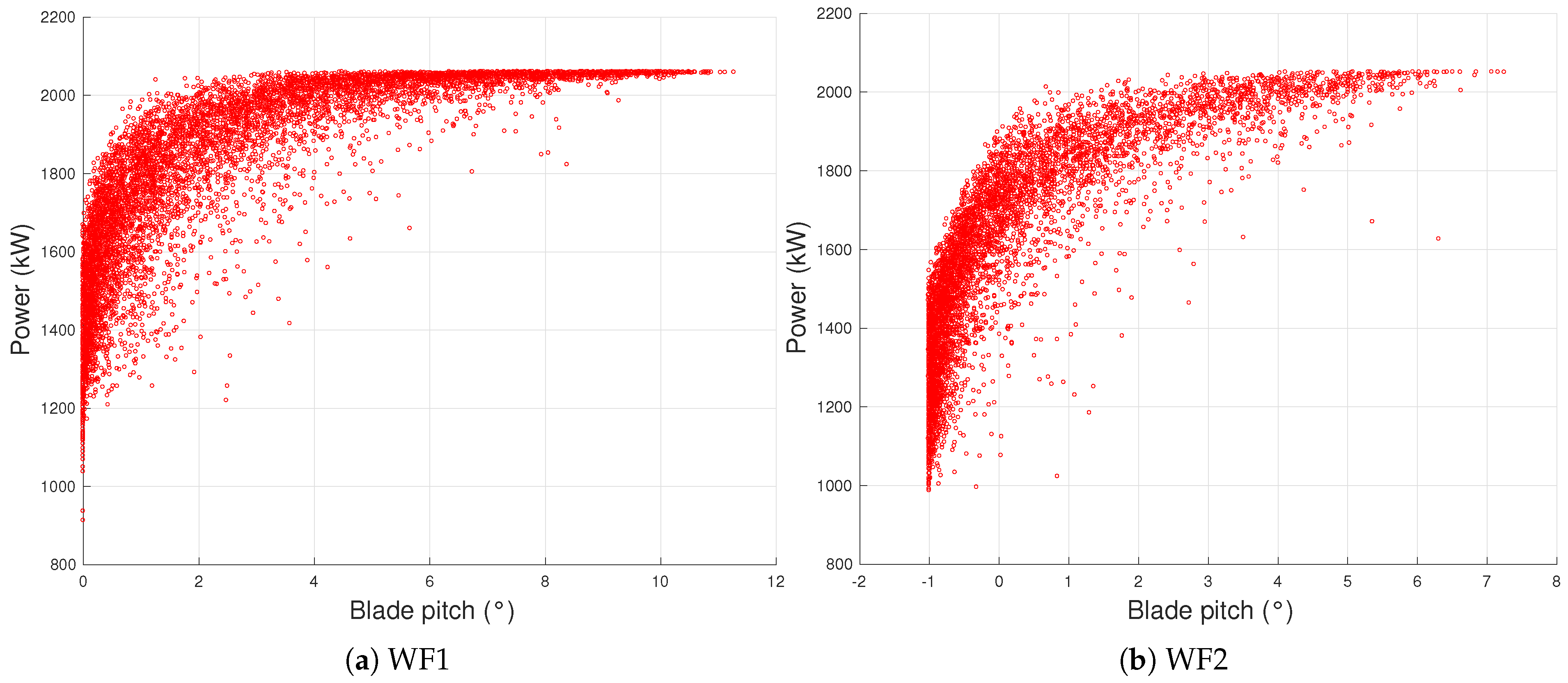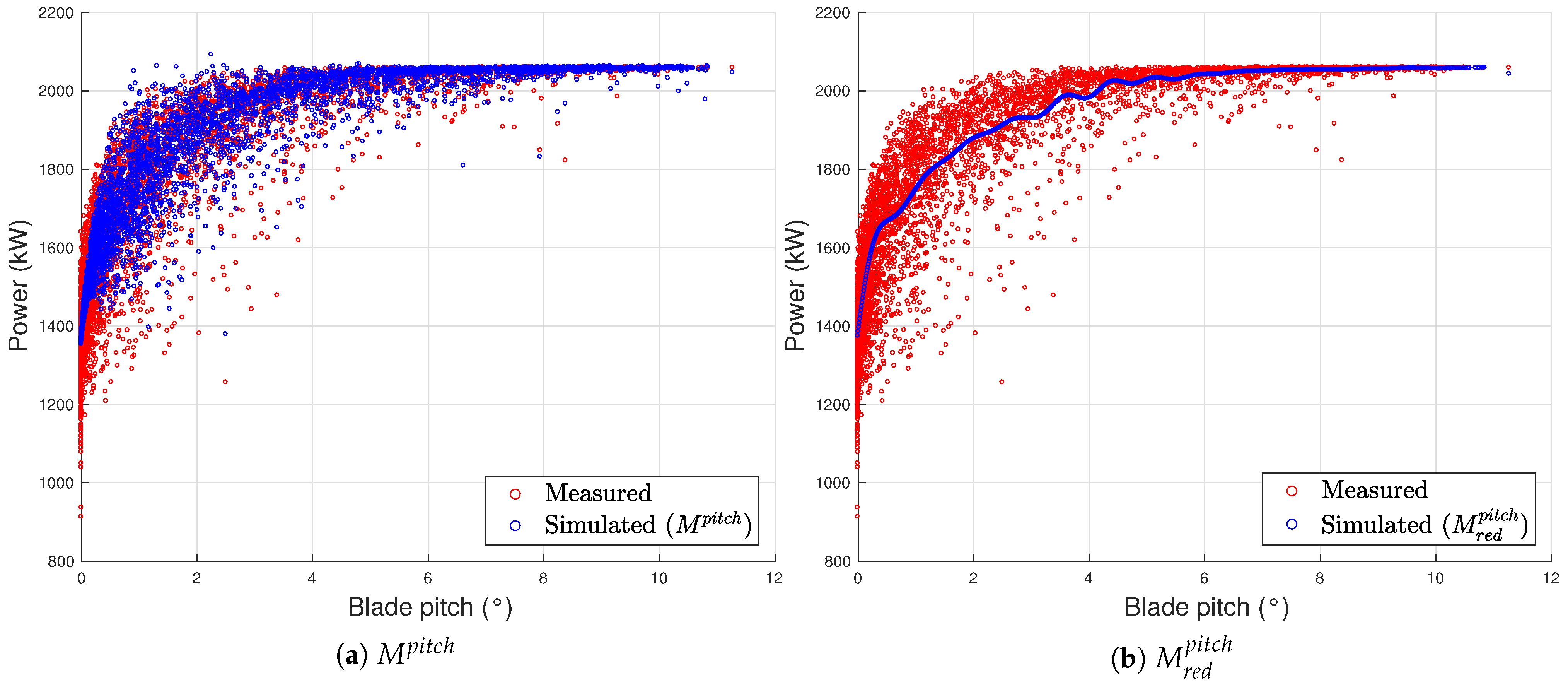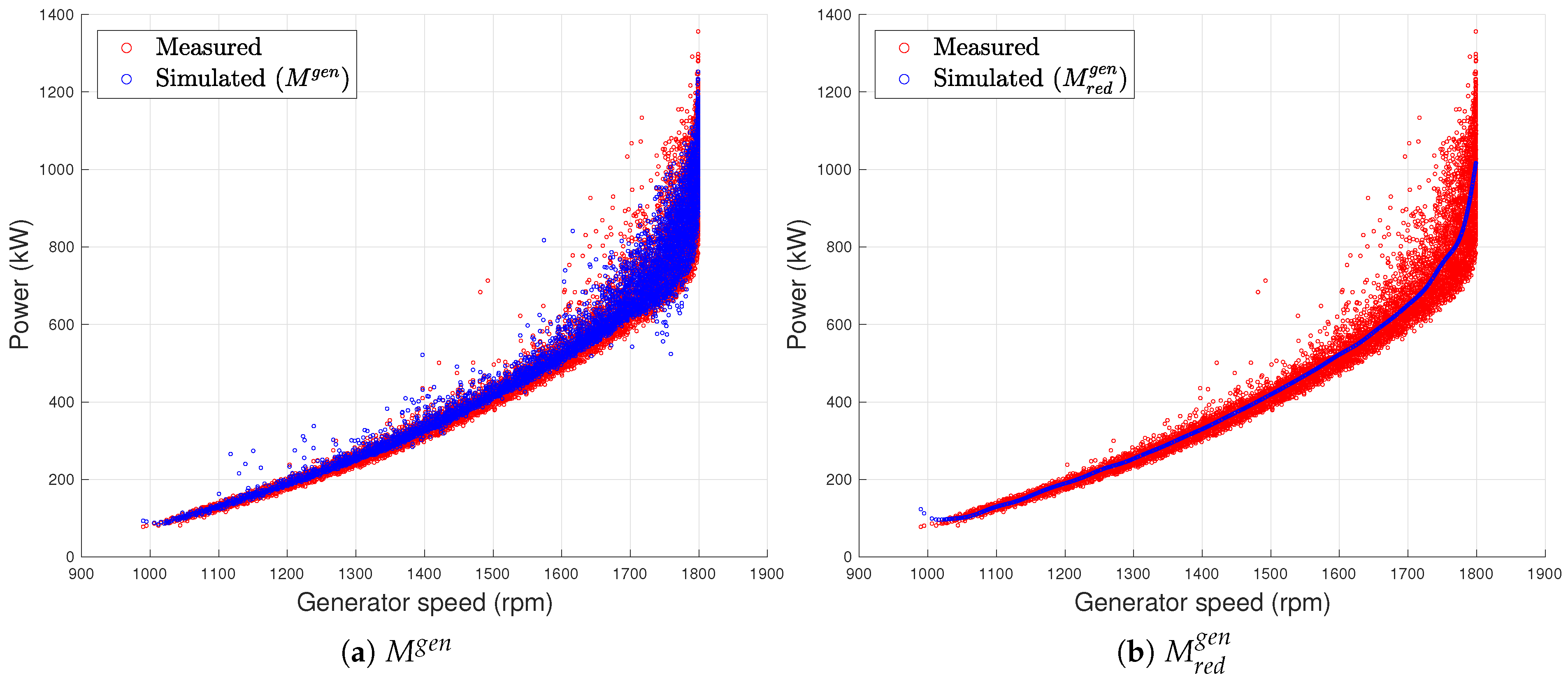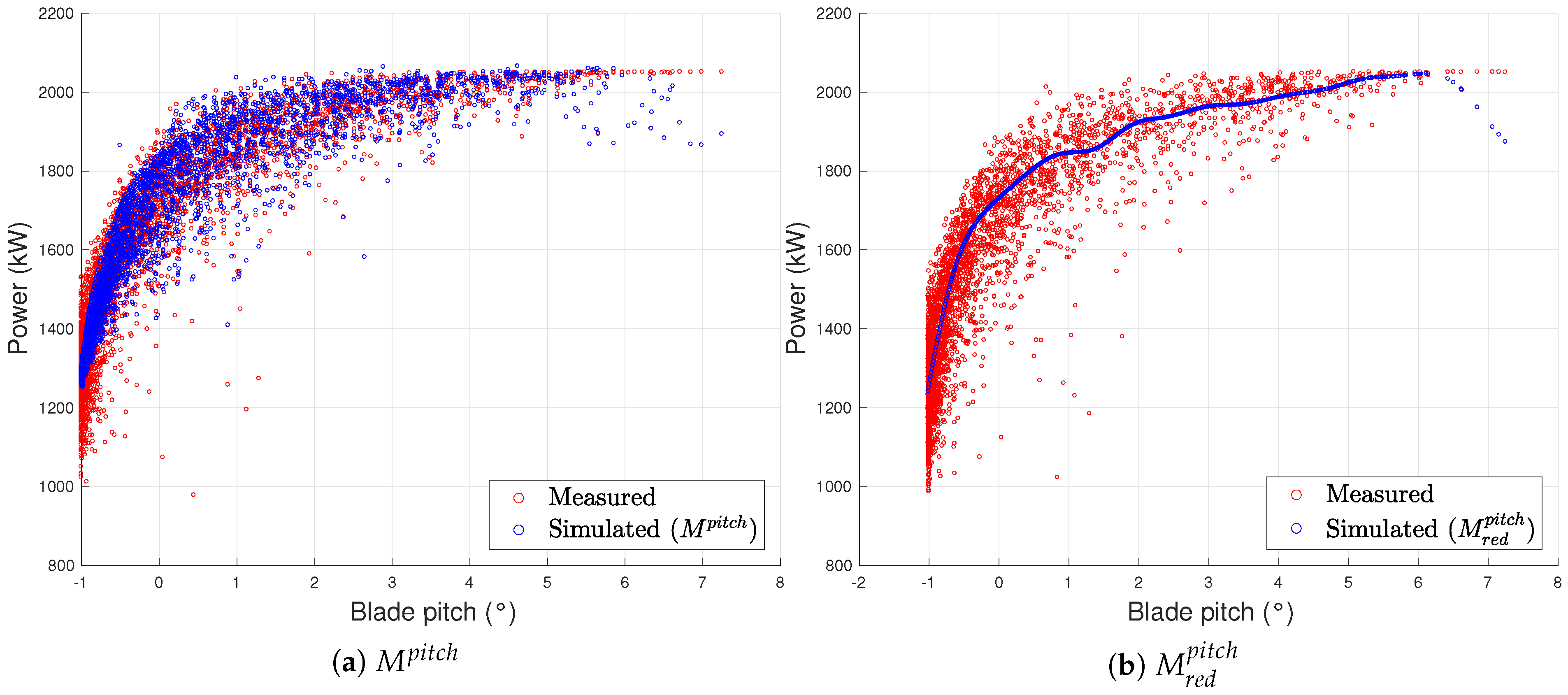1. Introduction
Operation and maintenance of wind turbines represent an important fraction (up to 20–25%) of the life-cycle costs of an industrial plant. Furthermore the recent trends about increasing rotor sizes [
1,
2] and offshore exploitation [
3,
4,
5] complicate the accessibility to wind turbine sites and increase the intervention costs in case of unexpected wind turbine stops.
For these reasons, and also in light of the non-stationary conditions to which wind turbines are subjected, remote control and monitoring [
6,
7] of wind farms is an objective whose importance has been continuously growing. Fortunately, the widespread diffusion of Supervisory Control And Data Acquisition (SCADA) control systems and of Turbine Condition Monitoring (TCM) systems guarantees the availability of most of the data which are necessary for wind turbine control and monitoring. Nevertheless, transforming the available information into knowledge about the health status or the performance of wind turbines is particularly complex. For example, as regards the detection of mechanical damages at gears and bearings through vibration data analysis, it is prohibitive to isolate the signatures associated to incoming faults [
8,
9,
10,
11].
As regards the monitoring of wind turbine performance, the main issue is that a wind turbine has a multivariate dependence on environmental conditions [
12,
13] and working parameters. SCADA control systems typically record and store (with some minutes of sampling time) the main working parameters and also internal temperatures collected at meaningful wind turbine sub-components. By this point of view, therefore, the main issue is incorporating efficiently this kind of information for constructing normal behavior models for the performance of the wind turbines [
14,
15,
16,
17], which can useful as well for condition monitoring purposes [
18,
19].
The simplest data-driven model employed for wind turbine performance monitoring is the power curve [
20,
21,
22,
23], which is the relation between the average wind speed and the extracted power. On the grounds of the above discussion, a recent trend in wind energy literature regards multivariate approaches to the power curve: in [
24,
25,
26], the point of view is including additional environmental variables (either measured ambient temperature, humidity, and wind direction as in [
24] or estimated by a Numerical Weather Prediction model as in [
25]); in [
27,
28,
29,
30], the approach consists in including the most important operation variables (as the blade pitch and the rotor speed) in the multivariate modelling of the power curve.
An interesting approach to wind turbine power monitoring consists in the analysis of other operation curves, mainly regarding the rotor speed and the blade pitch. In [
31,
32], the wind speed-blade pitch curve of wind turbines is analyzed using Support Vector Regression and the results are compared against the binning method. In [
33], two fundamental operation curves are analyzed through Gaussian process methods: the wind speed-blade pitch and the wind speed-rotor speed curves.
A further development of these concepts regards the analysis of operation curves which do not involve the wind speed measured at the nacelle of the wind turbines. The rationale for this consideration is that in general the nacelle wind speed is measured behind the rotor span and the undisturbed wind speed is estimated through a nacelle transfer function: this introduces possible drawbacks, especially in complex environment. Furthermore, it is not rare that nacelle anemometers are subjected to failures or bias [
34]. These considerations have even led to the formulation of the concept of rotor equivalent wind speed [
35,
36]: the idea is that, since the rotor speed is controlled on the grounds on the torque and not on the grounds of the nacelle anemometer, the rotor itself can be considered as a probe for estimating the wind speed.
Therefore, this study is devoted to the data-driven analysis of three operation curves, which are rotor speed-power, generator speed-power and blade pitch-power curve. To best of the author’s knowledge, despite the potential interest of these curves in wind turbine power monitoring, this topic has not been addressed systematically in the literature, except for the intuition contained in [
37], regarding the fact these curves can be particularly meaningful for wind turbine aging estimation.
The objective of this study is formulating a methodology for monitoring the performance of wind turbines using the above indicated curves: this in practice has been realized by verifying the robustness of a non-linear multivariate regression, which can therefore be employed as a normal behavior model for comparing the expected performance against the actual performance.
The data analysis is appropriately conducted in light of the principles of the control of wind turbines: for moderate wind speed (approximately between 5 m/s and 9 m/s), the blade pitch is kept fixed and the wind turbine attains the highest possible aerodynamic efficiency by regulating the rotor speed; for higher wind speed (approximately between 9 m/s and 13 m/s), the wind turbine operates in partial aerodynamic load by keeping constant the rotational speed and by regulating the blade pitch. These two operation regions are typically overall indicated as Region 2 of the power curve of a wind turbine, because they are between cut-in and rated: in [
37], in order to distinguish them, they are indicated as Region 2 and Region 2
and the same notation is employed in this study. Therefore, in this work, the selected operation curves are analyzed in the regions where they are of most interest for performance monitoring purposes: rotor and generator speed curves in Region 2, blade pitch curve in Region 2
. The interest for the blade pitch-power curve regards also the fact that, when the rotor speed saturates, the rotor equivalent wind speed becomes meaningless and therefore it is conceivable to use the blade pitch curve as the basis for a sort of pitch equivalent wind speed.
Due to the non-linear relation between the input variables and the power output, the selected methodology for the analysis of the curves is a Support Vector Regression with Gaussian Kernel. An innovative aspect of this study deals with the selection of the set of covariates for the regression. In the literature about wind turbine power monitoring, it is typical that the selected covariates are the average values as stored by the SCADA control system, but it should be noticed that SCADA systems store as well the minimum, the maximum and the standard deviation in the sampling interval for each measured channel. In this study, the possibility has been explored of including also minimum, maximum and standard deviation of the selected input variables, in order to inquire within what extent the normal behavior model improves. Sideways, this simple idea, which is enriching the covariates structure rather than complicating the model structure, could be inspiring for multivariate power curve modelling because the critical point is exactly reproducing the observed variability of the extracted power, given average conditions.
The main result of this work therefore consists in the verification that, using the proposed methodology, it is possible to model the power of a wind turbine with a precision which is competitive with the state of the art in the literature, but without using the nacelle wind speed as input variable: this is definitely non-trivial because, as discussed for example in [
27], the wind speed explains up to 98% of the variance of the power of a wind turbine.
Summarizing, the structure of the manuscript is therefore the following: in
Section 2, the test case and the data sets used for the present study are described;
Section 3 is devoted to the methods; the results are collected and discussed in
Section 4; conclusions are drawn and further directions of the present work are indicated in
Section 5.
2. The Test Cases
The selected test cases were two wind farms (named as WF1 and WF2) sited in southern Italy on gentle terrains, featuring respectively six and nine wind turbines whose rated power was 2 MW. The rotor diameters at WF1 was 92 m and at WF2 was 82 m. The layouts are reported in
Figure 1 and
Figure 2: from these Figures it arises that the interturbine distance at WF1 was considerably higher with respect to WF2. Therefore, the impact of wakes on wind turbine operation was low for WF1, while it was relevant for WF2 (as discussed, for example, in [
38,
39]).
Operation data spanning the years 2017 and 2018 were used, courtesy of the ENGIE Italia company. The measurements used were the following:
nacelle wind speed v;
power production P;
blade pitch ;
rotor speed ;
generator speed .
The data had 10 min of sampling time. For each channel, average, minimum, maximum and standard deviation over the 10 min interval have been used.
Data were pre-processed by filtering on wind turbine operation using the appropriate run time counter available in the SCADA data set. Subsequently, each data set was divided according to the operation region, as indicated in
Table 1, on the grounds of nacelle wind intensity
v. The same notation as in [
37] was adopted: the regime when the wind turbine operated at full aerodynamic load, with variable rotational speed and fixed pitch, is indicated as Region 2; instead, the regime characterized by rated rotational speed and variable pitch is indicated as Region 2
.
Examples of the operation curves under analysis were reported for a sample wind turbine (T1) for each test case in
Figure 3 (generator speed-power),
Figure 4 (rotor speed-power) and
Figure 5 (blade pitch-power): from these Figures, it arises that the curves were qualitatively similar and therefore the logic of the control was the same.
3. The Method
The objective of the study was formulating a reliable methodology for wind turbine power monitoring using the selected operation curves, depending on the working region. This passes through the construction of a normal behavior model for the curves and consequently consists in the comparison between the model estimates and the measurements in the validation data set. In this study, a Support Vector Regression with Gaussian Kernel was selected for constructing the normal behavior models because this kind of regression has proven to be effective for multivariate modeling of wind turbine power [
37,
40]. In the following, therefore, the general principles of the Support Vector Regression are briefly recapped and, subsequently, it will be discussed how to apply them for monitoring the operation curves of interest.
Given a matrix
of input variables, where the covariates are grouped according to the columns and the observations are grouped according to the rows, a linear model is posed in Equation (
1):
where
is the vector of regression coefficients and
is the intercept vector.
The Support Vector Regression consists in a methodology for estimating the
parameters. It relies on the constraint that the residuals between the measurement
Y and the model estimate
are lower than a threshold
for each
n-th observation Equation (16):
The optimization problem can be rephrased in the Lagrange dual formulation; the function to minimize is
, given in Equation (
3):
with the constraints Equation (
4)
where
C is the box constraint.
The solution for the
parameters in terms of the observations matrix
and of
or
is given in Equation (
5):
In a nutshell, the optimization passes through the data-driven selection of the most meaningful rows of the observations matrix , which for this reason are named support vectors and which are weighted through the or coefficients.
Once the
coefficients have been computed on a reference data set, they can be used for predicting new values through Equation (
6), given the input variables matrix
:
The non-linear Support Vector Regression is obtained by replacing the products between the observations matrix with a non-linear Kernel function Equation (
7):
where
is a transformation mapping the
observations into the feature space.
A Gaussian Kernel selection is given in Equation (
8) and has been widely employed in wind energy literature for non-linear regression problems [
31]:
where
is the Kernel scale.
Then Equation (
3) rewrites as in Equation (
9):
and Equation (
6) for predicting rewrites as in Equation (
10):
In this work, the hyperparameters of the regression , C, have been automatically optimized, basing on the evaluation on 30 model calls of the cross-validation loss.
In order to appreciate the usefulness of the selected non-linear regression for the problem of this study, a comparison is set up against a multivariate linear model: Principal Component Regression [
41].
The ordinary least squares estimate of the linear model coefficients Equation (
1) is given in Equation (
11):
If the input variables of the matrix are strongly correlated, the estimate of the coefficients is affected by large uncertainty: for this reason, the idea of of the Principal Component Regression is constructing an input variables matrix having mutually orthogonal columns.
Given the singular value decomposition of
in Equation (
12)
the columns of
and
are orthonormal sets of vectors denoting the left and right singular vectors of
and
is a diagonal matrix, whose elements are the singular values of
.
Therefore, the matrix
can be decomposed as:
where
and
.
The Principal Component Regression poses an ordinary least squares model between the transformed data matrix
and the target
Y. Therefore, the estimate of
is given in Equation (
14):
Once
has been calculated using training data, the model can be used for predicting through Equation (
15):
which is the corresponding of Equation (
10) for the Principal Component Regression.
The data sets used for this study were employed as follows for the regression:
The quality of the regression was analyzed through common error metrics, which were the Mean Absolute Error (), Mean Absolute Percentage Error () and Root Mean Square Error ().
Given the measurements
for the data set D2 and the model estimates
, the residuals are defined in Equation (16):
The MAE is defined in Equation (
17):
where
N is the number of samples in the D2 data set. The MAPE is defined in Equation (
18):
and the
is defined in Equation (
19):
where
is the average residual in the data set D2.
Finally, the selected structure of the regression was the following: for each curve, the columns of the
matrix were constituted by the corresponding independent variable (generator speed, rotor speed, blade pitch respectively). The main novelty proposed in this manuscript as regards covariates selection was to include also the minimum, maximum and standard deviation as further regressors in addition to the average value. Therefore for, say, the generator speed-power curve regression, the
matrix was constituted by average, minimum, maximum, standard deviation of the generator speed and the output
Y will be the power
P. In the following, this kind of model will be indicated as
M. In order to provide a benchmark more in line with previous findings in the literature, a reduced model (indicated as
) was analyzed as well: in this case, the unique covariate was the average value of the independent variable of interest (for example, the generator speed for the generator speed-power curve) and therefore the model was univariate non-linear. Furthermore, for the
M multivariate models, the Support Vector Regression and the Principal Component Regression were set up and the results were compared, while the univariate linear model was discarded because it was too simple for the problem. Summarizing, for each curve a comparison of univariate and multivariate non-linear models was performed (
M against
), in order to appreciate the importance of the additional covariates selection proposed in this study. Furthermore, for the multivariate models, a comparison of non-linear (Support Vector) and linear (Principal Component) regression was performed, in order to appreciate the importance of non-linearity. Therefore, the structure of the employed regressions is summarized in
Table 2.
5. Conclusions
The objective of the present study was contributing to the SCADA data analysis techniques for wind turbine power monitoring. The main innovative points are substantially two:
instead of analyzing the power curve from cut-in to rated, other meaningful operation curves are considered and each of them is studied in the appropriate working region of the wind turbines;
the curves are studied through a multivariate Support Vector Regression with Gaussian Kernel and the set of covariates has been augmented by including in the input of the models the minimum, maximum and standard deviation of the independent variables.
Three curves have been selected, which have not been addressed in detail in the literature before:
generator speed-power;
rotor speed-power;
blade pitch-power.
A model for the curves of interest has been set up using a Support Vector Regression with Gaussian Kernel. The data sets employed for training and testing come from 152 MW wind turbines from two industrial wind farm (owned by ENGIE Italia): the two test cases have been selected because one is characterized by frequent operation under wakes and the other is not.
The main result of this study is that targeting the curves and using the covariates selected in this study, it is possible to model the power of a wind turbine with results which are competitive with the state of the art in the literature as regards multivariate power curve modelling. Therefore, there is no con in renouncing to use nacelle wind speed measurements for wind turbine power monitoring, if the appropriate operation curves are selected and if the models are set up appropriately. Instead, the possible advantages of adopting this point of view are several:
using operation curves which do not employ the nacelle wind speed as independent variable, it is possible to compare the performance of wind turbines of the same model which are sited in different environments. This is in general not possible using the power curve, because the nacelle transfer function depends on wind shear, turbulence, atmospheric stability and so on.
the selected operation curves are particularly appropriate for interpreting the performance of wind turbines in relation to the behavior of the main sub-components and this represents an added value with respect to the power curve, which connects directly the wind flow to the power output.
As regards the latter point, actually, it should be noticed that the generator speed-power curve has been analyzed in the context of wind turbine aging analysis in [
37]: despite the methodology employed in that study was simpler with respect to the analysis proposed in this work, it has been sufficient to highlight a considerable under-performance of a wind turbine because of generator efficiency aging. Another potential application of this kind of methodology is the analysis of wind turbine optimization technology, which likely intervenes with slight modifications of the characteristic operation curves of the wind turbines (see for example [
42,
43,
44,
45,
46]), involving the rotational speed and-or the blade pitch control. A practical approach for assessing the net effect of this kind of technology upgrades is training a model (similar to those presented in this work) with data before the technology upgrade, validating on two target data sets (one before and one after the upgrade) and analyzing how the statistical properties of the residuals between model estimates and measurements change.
Another fruitful result of the present study is the analysis of how much the error metrics for the selected curves modeling diminish when the set of covariates includes minimum, maximum and standard deviation of the independent variable (in addition to the average value): a percentage decrease of order of one third is achieved, with respect to the same kind of model employing only the average of the variable of interest. Since the variability of the main working parameters (as for example the rotational speed) is substantially connected to the turbulence intensity, by incorporating the additional covariates proposed in this work it is possible to construct normal behavior models which are site-specific, because they take into account the conditions which are measured on site and the response of the machine. This inspires as further direction to adopt a similar approach also for multivariate wind turbine power curve modelling: actually, there is a wide literature about the improvement of the model structure, while the discussion about the use of further covariates is at its early stages. In [
24,
25,
27,
28,
29], multivariate models for the power curves have been proposed, which include further environmental and operation variables with respect to solely the average nacelle wind speed, but at present there are no studies dealing with the inclusion in the models of minimum, maximum and standard deviation of the main variables. Finally, it would be extremely interesting to analyze the operation curves selected in this study by using time-resolved wind turbine data [
47] having much lower sampling time (order of seconds).
